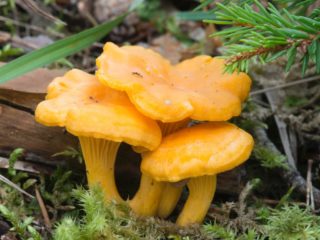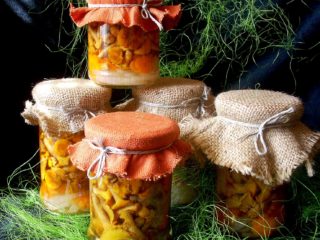Content
The humpbacked chanterelle is a lamellar mushroom that is rare in Russia. It is not in demand among mushroom pickers due to its small size and inconspicuous coloring of the fruit body. The mushroom is suitable for consumption, but does not have a pronounced aroma and taste, and is not of particular value in culinary terms.
Where do humpback chanterelle mushrooms grow?
The main distribution of the humpbacked chanterelle, otherwise Cantarellula tubercula, is in the European, central parts of Russia, and the Moscow region. This is an infrequently encountered species, grows only in groups, and produces a stable harvest every year.Mushrooms are collected from late August to September. In regions with early winter, the end of the humpback chanterelle mushroom season often coincides with the appearance of the first snow.
Chanterelles grow in families in a row or form large circles and occupy a large area on a moss cushion. They are more often found in damp forests under pine trees, but can also grow in dry coniferous forests. The collection time falls during the main mushroom season, when there are more valuable mushrooms from an economic point of view, so the humpbacked chanterelle is rarely paid attention to. Less experienced mushroom pickers consider the humpbacked chanterelle to be poisonous due to its unusual appearance. The fruiting body is not only edible, but also, due to its chemical composition, has a certain nutritional value.
What humpbacked foxes look like
Cantarellula is difficult to confuse with other species; in appearance it does not remotely resemble the usual classic chanterelle. The fruit body is small, which does not add to the popularity of the mushroom; the color is gray or dark ash, uneven.
The cap has a regular round shape - 4 cm in diameter, and may be slightly wavy if the chanterelle is overripe. The surface is smooth, lighter at the edges, dark in the middle with concentric circles of steel color. A cylindrical bulge is formed in the central part; the tubercle is present in young and mature specimens. As it grows, a shallow funnel forms around it. The edges of the cap are slightly concave inwards.
The lamellar spore-bearing surface is dense, the plates are forked-branched, densely located, descending to the upper part of the fruit stalk. The underparts of the chanterelle are white with a slight gray tint. In the line of transition from the cap to the stem, the plates are covered with rare inclusions in the form of red dots.
The leg is straight, rounded, covered with a dense white coating on top. The length depends on the layer of moss, on average 8 cm. The diameter along the entire length is the same - within 0.5 cm. Near the mycelium the color is light brown, towards the cap it is closer to white. The leg is solid, the inner part is hard and dense.
The pulp is soft, the water concentration is insignificant, therefore the structure is brittle, the color is white with a barely noticeable gray tint. The smell is subtle, mushroom, not pronounced. There is no bitterness in the taste. The cut area turns red during oxidation.
Is it possible to eat humpback chanterelles?
In terms of nutritional value and taste, humpback chanterelles belong to the 4th last classification group. Cantarellula is characterized as a conditionally edible mushroom, non-toxic to humans. The group includes numerous representatives; they are also divided according to the degree of nutritional value.
In the upper part of the fruit body, cap and part of the leg of the humpback chanterelle, the concentration of nutrients is not inferior to the classic type. Chanterelle is used only after heat treatment. For example, mushrooms are not suitable for drying.
Taste qualities
Each type of mushroom has its own aroma and taste. Some qualities are clearly expressed, while others are more weakly expressed. Cantarellula has a pleasant taste, the fruit body after processing has a subtle mushroom taste, tender, without bitterness, not bland. Mushrooms do not require pre-soaking or labor-intensive processing. The only disadvantage of the humpbacked chanterelle is the complete absence of smell. If raw fruiting bodies have a barely perceptible mushroom aroma, then after processing it disappears completely.
Benefits and harms
The chemical composition of the humpbacked chanterelle is quite diverse; the main composition is elements involved in many metabolic processes in the human body. Chanterelles have medicinal properties and are widely used in folk medicine. If the gastronomic value of cantarellulus is low, then the medicinal properties are at the proper level. The fruit body contains vitamins: PP, B1, E, B2, C. Macroelements:
- calcium;
- sodium;
- potassium;
- phosphorus;
- magnesium;
- chlorine;
- sulfur
Microelements:
- iron;
- zinc;
- copper;
- fluorine;
- cobalt;
- manganese.
The chemical composition includes proteins, carbohydrates, amino acids. The humpback chanterelle contains a unique substance - quinomannose, which is toxic to helminths and can destroy parasites and their eggs. During heat treatment, the substance disintegrates. Therefore, for medicinal purposes, cantarellula is dried and ground into powder.
Beneficial effects on the body of the humpbacked fox:
- cleanses and restores liver cells;
- inhibits the division of cancer cells;
- participates in the processes of the digestive tract;
- strengthens the walls of blood vessels;
- serves as a prevention of cardiovascular diseases;
- improves vision;
- strengthens the immune system;
- gets rid of helminths.
There is no harm from mushrooms, it is only recommended that women during lactation and people with individual intolerance refrain from using them.
Collection rules
The humpback chanterelle collection season begins in early autumn and can last until frost sets in. Mushrooms grow on moss litter, in damp or dry coniferous forest. When collecting, pay attention to the condition of the fruiting body; do not take overripe ones. Do not collect in industrial zones, near highways, treatment facilities, or landfills.Mushrooms from the air and soil absorb and accumulate heavy metals and toxic compounds; their consumption is not recommended.
False counterparts of humpback chanterelles
Fungi of the 4th group rarely have doubles; some of them themselves are classified as false. The humpbacked fox does not have an officially recognized counterpart; there are two species that are considered to be false.
In the photo, the double of the edible cantarellula humpback is the false convex chanterelle, it has:
- bright yellow color of the cap and a different shape;
- clearly defined funnel and lack of convexity in the center;
- the leg is shorter, hollow, dark;
- the planting of the plates is rare;
- there are no red spots near the transition to the leg;
- the presence of snails is visible; the humpbacked fox is not eaten by insects and worms.
The smell of the double is sharp, herbaceous, and the taste is bitter. Grows singly on moss or leaf cushions, rarely in pairs. The flesh does not turn red when cut.
Photo of another similar species of the Ryadovkov family, which includes the humpbacked fox - the blue-gray chanterelle. It grows in families, often located next to the cantarellula, without close attention they can be confused. A closer look reveals the differences. The plates do not fall onto the leg. The shape of the cap is sloping, without a depression or convexity at the center.
Application of humpback chanterelles
Chanterelles are used in cooking only after cooking. The water is poured out; it is not used for cooking. Application:
- Humpbacked chanterelles are salted in large and small containers.
- Fried with onions or potatoes.
- Stewed with sour cream.
- Soup is being cooked.
In preservation they are used only assorted. Mushrooms do not lose their unusual color after processing. Winter preparations serve not so much a gastronomic as an aesthetic function.Boil and freeze in the freezer. Used in traditional medicine recipes.
Conclusion
The humpbacked chanterelle is a small leafy mushroom that grows on moss litter in pine and mixed coniferous forests. In terms of nutritional value it belongs to the 4th group. The chemical composition is not inferior to the classic type. The mushroom is suitable for consumption; it is fried, boiled, and used in winter preparations.












